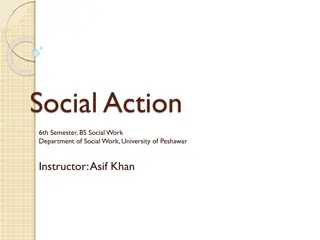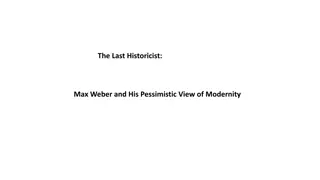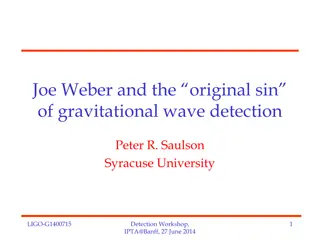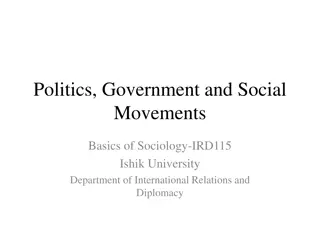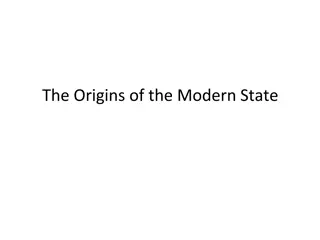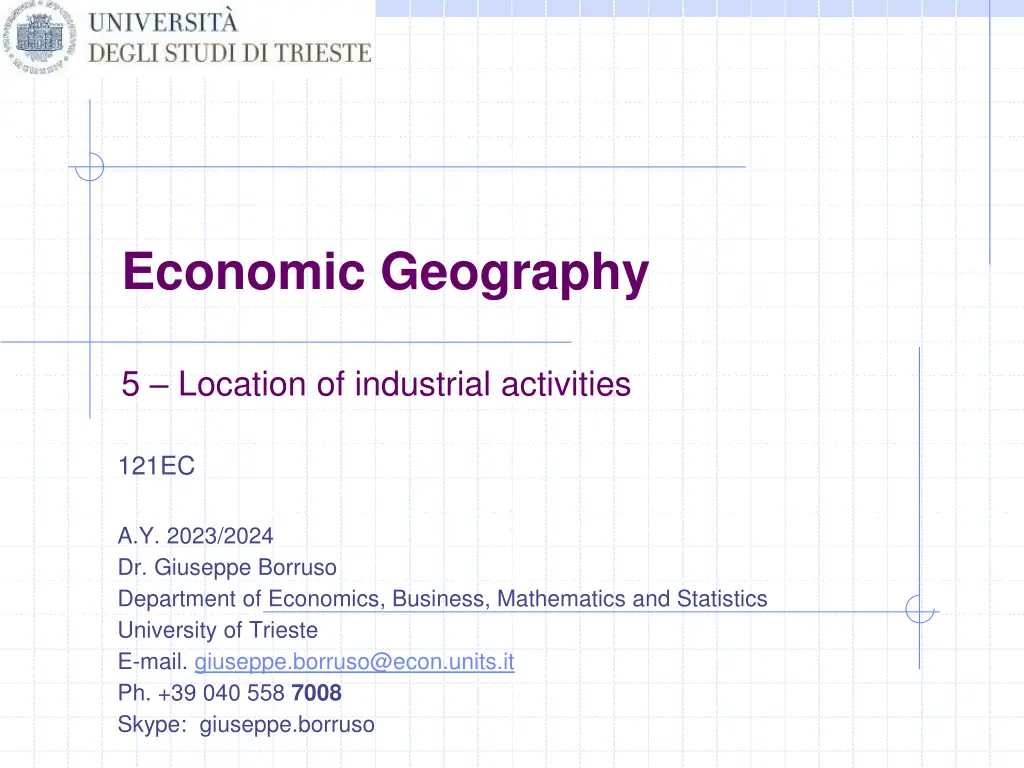
Optimal Location of Manufacturing Plants According to Weber's Model
Weber's industrial location theory explains how the optimal location of manufacturing plants is influenced by transport costs, weight of materials, and final products. The model by Alfred Weber considers factors like resource localization, transport costs, and material index to determine the ideal plant location between raw material sources and marketplaces.
Download Presentation

Please find below an Image/Link to download the presentation.
The content on the website is provided AS IS for your information and personal use only. It may not be sold, licensed, or shared on other websites without obtaining consent from the author. If you encounter any issues during the download, it is possible that the publisher has removed the file from their server.
You are allowed to download the files provided on this website for personal or commercial use, subject to the condition that they are used lawfully. All files are the property of their respective owners.
The content on the website is provided AS IS for your information and personal use only. It may not be sold, licensed, or shared on other websites without obtaining consent from the author.
E N D
Presentation Transcript
Economic Geography 5 Location of industrial activities 121EC A.Y. 2023/2024 Dr. Giuseppe Borruso Department of Economics, Business, Mathematics and Statistics University of Trieste E-mail. giuseppe.borruso@econ.units.it Ph. +39 040 558 7008 Skype: giuseppe.borruso giuseppe.borruso@econ.units.it
Industrial location theory Weber s model
According to Weber, the optimal location of manufacturing plants depended on transport costs from material places and to market places and on the weight of materials and final, transformed products. The model was mainly aimed at explaining the location choices of industrial areas of the time, namely the Ruhr region in Germany in the years of this country s industrial revolution . The model was a typical product of that linear scheme of the classical economic theory : extraction of resources - manufacturing - distribution to the market. In such a scheme, enters space: namely as an origin of resources and as place of disposal of waste, without caring about their destiny. Alfred Weber in his essay on the Theory of Industrial Location set some simplifying assumptions, as the fixed locations of all inputs and market, and the fact that the manufacturing firm chooses the best location where the sum of the total transport costs, incoming and outgoing, is minimized. In the most basic version of the model the industry uses only one input material localized at a given location of a homogeneous plane and sells its output in a unique market localized in the same plane. Technology is allowing constant returns of scale and not allowing input substitution. As anticipated, the weberian models can be applied to manufacturing firms acquiring physical quantities of input materials, intermediate products and fuel as inputs in the production process and a certain quantity of products as output. In Weber s hypotheses it is important the classification of resources. Weber talks about localized materials (inputs), as those having a fixed location in space, furtherly organized in pure - they are completely used into the production process and therefore in the final product - and gross - the lose some weight during the production process, and therefore having only a part into the final product. Other resources are defined as ubiquitous or non localized, being fairly uniformly distributed and accessible in space. As far as transport costs, these can be considered as assembly costs - transport cost of raw materials from sources to manufacturing plants - and distribution costs - transport cost of final products from the production plants to the marketplace. The theory states that transport costs are a constant multiplied by the number of ton-km - as there are not terminal costs; the cost per ton- km is the same for input and output; transport is constant in each direction. The firm is also a price taker in terms of costs, holding a perfect information necessary to calculate accurately the transport costs.
d(R) = Distance RF (resource site - production site) d(M) = Distance FM (production site market) The manufacturing firm F will locate in a point between the resource site R and the market place M. Such location will depend on the weight of the materials compared to the final product. Weber introduced an indicator called MI = Material index: MI = weight of the localized resources / weight of the final product Pure Resources: MI = 1 Gross Resources: MI > 1 In the case of pure resources entering completely into the final product, no waste will be available, and therefore the location will happen at an intermediate point between R and (first case, fig. 5) M. In the case in which gross resources prevail, (IM>1), localization will occur at a close proximity of the resources site R, to minimize transport costs of waste (3rd case, fig. 2). An extreme case is given by the localization in the market-place M, (second case, fig 2) in the case in which the final product is mainly realized using perishable resources available at the same market location - as water, for instance, considered as ubiquitous.
Location la Weber in the simplified model (along a line)
Webers Theory of industrial location Weber s model (Theory of the Location of Industries, 1909) The location of all input suppliers and market are fixed and firm must choose a location that will minimize the sum of its inbound and outbound transportation costs. Weberian models are best applied to a manufacturing firm which purchases physical quantities or raw materials, intermediate goods and fuels as inputs and produces some physical quantity of output. Space is characterized by: Uniform interest rate; Uniform production costs, wages, rents; Uniform and proportional to distance unitary transport costs; Resources consisting of: Localized materials (mine resources) Ubiquitous materials (water) Losing weight materials (raw material s weight is only partially reflected into the final product) Net materials (raw material s weight is totally reflected into the final product) The model is aimed at identifying the place where to locate a firm / plant minimizing costs related to places => Raw material places Energy places Market / consumption places
Webers model of industrial location Location on a line The firm uses one localized input available at a single point S on a featureless plane and sells of its output in a single market located at point M in the same plane The production technology of the firm yields constant return to scale and allows no input substitution Transportation costs are a constant times the number of ton-km (no terminal costs; cost per ton-km is the same for input and output; transportation is equal in all directions) The firm is a price taker that has complete knowledge of all information necessary to accurately calculate transportation costs. Its goal is to choose the location that minimizes its transportation costs. D - d d Production Facility Market Material source F S M X = weight of unit of localized input t = transport rate in per ton-km x = weight of unit of output D = distance SM d = distance FM D T = tX (D - d) + txd
Webers model of industrial location Assembly, distribution and transport costs T = tX (D - d) + txd Assembly cost Distribution cost TC TC AC AC DC DC S S M M Assembly, distribution and total transportation cost for X<x Assembly, distribution and total transportation cost for X>x
Webers model of industrial location P2 M1 M1= Raw material M2 = Fuel (Energy) C= Market p2 1 p1 3 P3 2 p3 + + M Fp M Fp FCp 1 1 2 2 3 P1 Triangle of weights 1 2 F 3 Locational Triangle M2 C
Alternatives: the Varignon Machine The idea is to take a board and drill holes through all the points. Next, we hang a weight through each hole using a string. We tie all the strings together at one point above the board, and let the system balance itself out. Under unreasonable physical assumptions (i.e., no friction, etc) the knot will be located at the one median. It is intuitively clear why this is the solution, and a formal proof is easy. Interestingly, this machine was supposedly used in real life to solve the problem in some cases.
Webers model of industrial location From Isotims Curves with same transport cost Isodapane Curves with same TOTAL transport cost to
Building of the 15.000 isodapane from isotims referred to N and M 16.000 14.000 12.000 10.000 8.000 6.000 4.000 2.000 M N 1.000 2.000 3.000 4.000 5.000 6.000 7.000 9.000 11.000
Building of the 15.000 isodapane from isotims referred to N and M 16.000 14.000 12.000 10.000 8.000 6.000 4.000 2.000 M N 1.000 2.000 3.000 4.000 5.000 6.000 7.000 9.000 11.000
1.000 1.000 2.000 2.000 3.000 3.000 4.000 4.000 1.000 Building of the 8.000 isodapane from isotims referred to A, B and C 2.000 (transport costs =) 3.000 4.000
7.000 6.000 3.000 4.000 2.000 1.000 2.000 B A C 1.000 Building of the 8.000 isodapane from isotims referred to A, B and C 2.000 (different transport costs) 4.000 3.000
Webers model of industrial location Weber choice according to a comparison of saving in workforce and increased transport costs, (critical isodapane) (Points having higher transport costs equal to savings obtainable with lower workforce costs in locations Li) M1 L2 L1 1 2 F 3 M2 C
1.000 1.000 2.000 2.000 3.000 3.000 4.000 4.000 1.000 2.000 3.000 4.000
Smith satisfactory solutions Isodapane concept Developed by Weber Weber s isodapane is defined as a line of equal total transport cost For Smiths the isodapanes are cost isopleths or cost contours = lines of equal transport cost. Space-cost curve = a section drawn through the cost-contour map. The lowest point is the least cost location Spatial margins of profitability => Manufactured product sold at same price in space Points within the price envelop will host optimal (satisfactory) solutions Transport-cost surface (a) and space-cost curve (b)
Smith satisfactory solutions A C a) B Transport cost surface (a) Costs and space-cost curve (b) Price Area of profit b) Least cost location O M N Distances
The main elements and trends of location Production functions Author Principle Technology Production costs (pareto optimum) (homogeneous, exogenus, Substantially stable) externalities (ininfluential) space (isotropic) Transport (physical distance) Locational Triangle Weber Weber + Mashall Production costs (Economies of scale) externalities (highly influential) Technology (variable, endogenous) space (territory) Transport (physical distance) Critical isodapane externalities (not Explicitly considered) Production costs (Economies of scale) Technology (not explicitly considered) Transport space (territor) Isocost curves Maximum profit Smith (Functional distance) Technology (homogeneos Low skills) Production costs (Maximization of economies of scale) space Isocost curves Maximum profit externalities (ininfluential) Transport (Hoover model) Perroux (Gravitational pole) Production costs (competitive advantages) Technology (variable and Highlly specialized) externalities (highly influential) space (spatial system) Transport (Hoover model) Diamond of competition Porter
References CONTI S., Geografia Economica, Torino, Utet, 1996 Porter, M. 1990. The competitive Advantage of Nations. New York: The Free Press. Porter, M.E. 1998. Clusters and the new economics of competition. Harvard Business Review 76 (6): 77-90. Porter, M.E. 2000. Location, competition, and economic development: Local clusters in a global economy. Economic Development Quarterly 14 (1): 15-34. Weber, A. 1929. Theory of the Location of Industries. Trans. Friedrich, C. J. Chicago: University of Chicago Press. Hoover, E. M. 1937. Location Theory and the Shoe and Leather Industries. Cambridge, MA: Harvard University Press. Hoover, E.M. 1948. The Location of Economic Activity. New York: McGraw Hill. Isard, W., Schooler, E. and Vietoricz, T. 1959. Industrial Complex Analysis and Regional Development. New York: John Wiley. Keeble, D. and Wilkinson, F. (Eds.) 2000. High-Technology Clusters, Networking and Collective Learning in Europe. Aldershot: Ashgate Krugman, P. 1991. Geography and Trade. Cambridge: MIT Press. Krugman, P. 1995. Development, geography, and economic theory. Cambridge: MIT Press. Krugman, P. and Venables, A.J. 1996. Integration, specialization, and adjustment. European Economic Review 40 (3-5): 959-967. Marshall, A. 1890. Principles of Economics. London: Macmillan.










